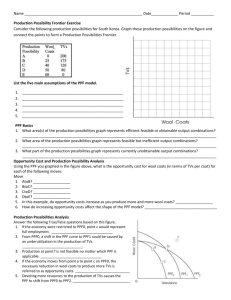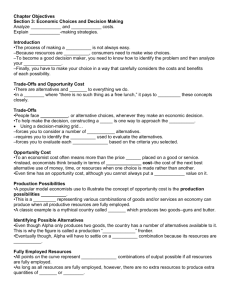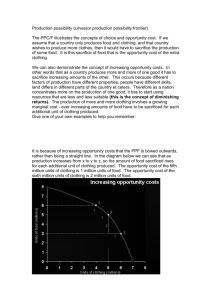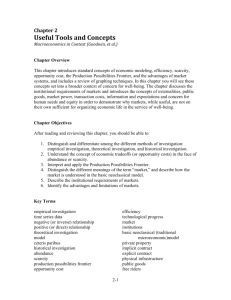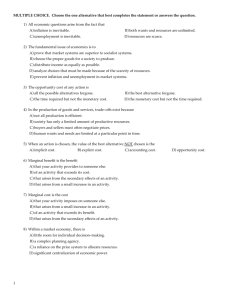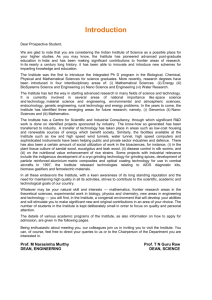SCARCITY, CHOICE AND THE PRODUCTION POSSIBILITIES
advertisement
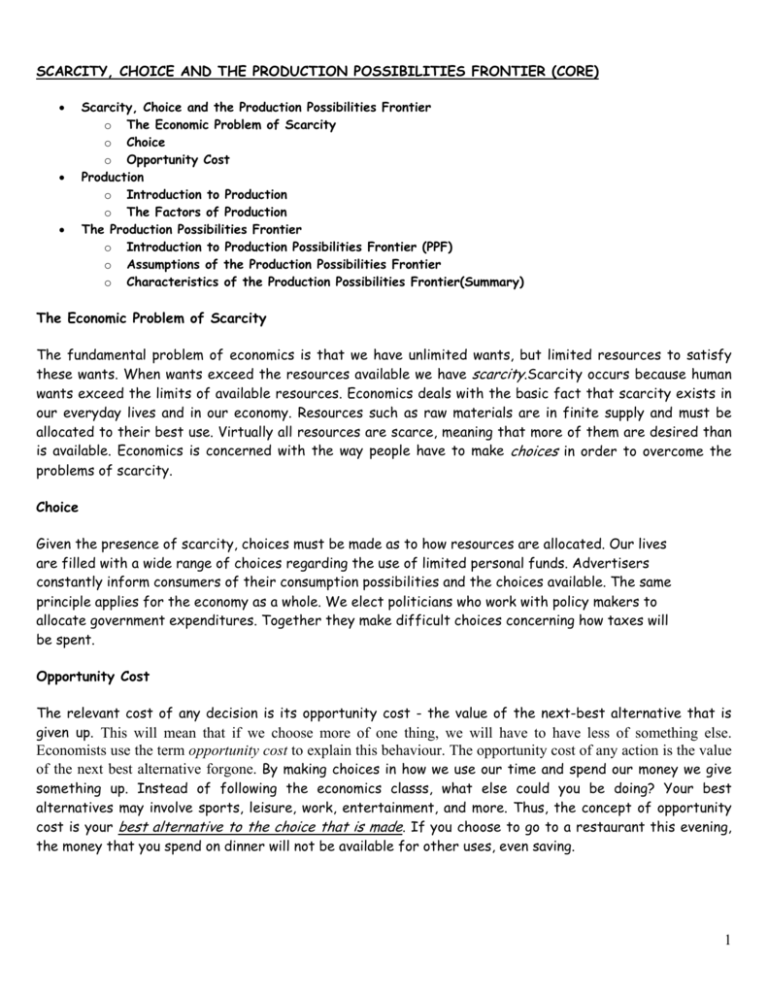
SCARCITY, CHOICE AND THE PRODUCTION POSSIBILITIES FRONTIER (CORE) Scarcity, Choice and the Production Possibilities Frontier o The Economic Problem of Scarcity o Choice o Opportunity Cost Production o Introduction to Production o The Factors of Production The Production Possibilities Frontier o Introduction to Production Possibilities Frontier (PPF) o Assumptions of the Production Possibilities Frontier o Characteristics of the Production Possibilities Frontier(Summary) The Economic Problem of Scarcity The fundamental problem of economics is that we have unlimited wants, but limited resources to satisfy these wants. When wants exceed the resources available we have scarcity.Scarcity occurs because human wants exceed the limits of available resources. Economics deals with the basic fact that scarcity exists in our everyday lives and in our economy. Resources such as raw materials are in finite supply and must be allocated to their best use. Virtually all resources are scarce, meaning that more of them are desired than is available. Economics is concerned with the way people have to make choices in order to overcome the problems of scarcity. Choice Given the presence of scarcity, choices must be made as to how resources are allocated. Our lives are filled with a wide range of choices regarding the use of limited personal funds. Advertisers constantly inform consumers of their consumption possibilities and the choices available. The same principle applies for the economy as a whole. We elect politicians who work with policy makers to allocate government expenditures. Together they make difficult choices concerning how taxes will be spent. Opportunity Cost The relevant cost of any decision is its opportunity cost - the value of the next-best alternative that is given up. This will mean that if we choose more of one thing, we will have to have less of something else. Economists use the term opportunity cost to explain this behaviour. The opportunity cost of any action is the value of the next best alternative forgone. By making choices in how we use our time and spend our money we give something up. Instead of following the economics classs, what else could you be doing? Your best alternatives may involve sports, leisure, work, entertainment, and more. Thus, the concept of opportunity cost is your best alternative to the choice that is made. If you choose to go to a restaurant this evening, the money that you spend on dinner will not be available for other uses, even saving. 1 Businesses and governments also deal with opportunity costs. Businesses must choose what type of goods to produce and the quantity. Given limited funds, the opportunity cost of producing one type of good will arise from not being able to produce another. Production occurs when we apply labour and capital to resources in order to increase the value of the resources. Given a scarcity of resources, it is desired that society will allocate them to their best uses. In many economies, the market performs most of the resource allocation role. Consumers indicate their preferences by purchasing goods and services. Producers wish to satisfy the demands of consumers by using scarce resources to produce those goods and services that consumers demand. The Factors of Production There are three major factors of production: 1. Land includes all natural resources, such as land, air, water, forests, wildlife, etc., 2. Labour includes all mental and physical effort exerted by human beings, 3. Capital refers to the improvements made to natural resources. Capital includes items such as buildings and machinery. While the definition of land and labor is readily apparent, let us briefly discuss the economic meaning of capital. Capital is used to assist labour in the production process and increase our capacity to produce goods and services. Workers use tools and machinery to become more productive and increase their output. In an economic sense we consider capital as the actual purchases of plant and equipment used in production. Investment is the term used to describe the additions to capital. By investing, a firm purchases new machinery that adds to its capital stock. THE PRODUCTION POSSIBILITIES FRONTIER (PPF) Introduction to the Production Possibilities Frontier (PPF) The production possibilities frontier is used to illustrate the economic circumstances of scarcity, choice, and opportunity cost. To describe the concept of the production possibilities frontier, assume that we live on an island that has only two cities (Lake and Desert), and two industries (cars and airplanes). Given the resources available on our island economy, the table below shows how labor and capital can be allocated to the production of autos and airplanes. 2 The Production Possibilities for a Single Country Option Cars/Automobiles Airplanes A 150 0 B 125 4 C 80 9 D 30 16 E 0 25 The table gives five production possibilities, options A through E. Each option shows what alternative mixes of cars and airplanes that society can choose to produce. Option A is one where our island dedicates all of its resources to the production of cars, entirely forsaking airplane production. Option B shows a preference for the production of a few airplanes, but giving up some automobiles in the process. The tradeoff of airplanes for autos continues to point E, where our country dedicates itself to the production of airplanes (25), producing zero automobiles. Figure 1-1 is a graphical representation of the information presented in table above. The boundary presented in the graph represents the different possibilities that society has in the allocation of resources. The frontier boundary and its interior represent what is achievable given our island's currently available resources. In contrast, points outside the frontier are not attainable given the resources and technology present. The PPF is a graphical representation of the data found in the table and is known as the production possibilities frontier. Beginning at the vertical (y) axis, we have point E from the table where there are 25 airplanes and no cars produced. As the table shows, point D represents an output level with fewer airplanes but more autos. We continue to move Southeast along the frontier until we reach point A. The y-axis shows the number of airplanes that can be produced. If we begin at the origin and refer to the table above, as we move up along the axis, our output of airplanes increases. The maximum number of airplanes that can be produced is 25 as given by production point E in the production possibilities. The x-axis shows the number of cars that can be produced. If we begin at the origin and refer to the table above, as we move to the right along the axis, our output of automobiles increases. The maximum number of cars that can be produced is 150 as given by production point A in the production possibilities Note two characteristics of the production possibilities frontier. First, it slopes downward to the right. This represents the tradeoff present in production. By producing more cars, workers and capital must migrate from Lake to Desert. An increase in car production necessitates a reduction in the output of airplanes. 3 In addition, the production possibilities frontier is "bowed outward." The curvature of the production possibilities frontier reflects the increasing opportunity cost when substituting one type of production for another. This situation is caused by the specialization of workers. If society initially favours car production over airplanes so that we are located in the southeast portion of the frontier, workers become skilled in car production. But as we move to the left along the curve, increasing airplane output and decreasing car production, some workers switch to making airplanes. For many workers, the skills used in producing autos are not perfectly transferable. In addition, the machinery used for auto production may not be well suited to making airplanes. As a result, the output per worker falls as they are relocated to making goods in which they are less skilled. Assumptions of the Production Possibilities Frontier There are 3 assumptions that must be satisfied if our country is to achieve a point along the production possibilities frontier. 1. Finite resources - at any given time, the total amounts of labour, land and capital are fixed. 2. Full and efficient use of the resources - at any point along the PPF we have productive efficiency. We cannot increase the output of one good without decreasing the output of another. 3. A given state of technology - the production possibilities frontier represents the technology available to producers. For our society to end up at a point along the production possibilities frontier we assume that resources are used fully and efficiently and that the best available technology is utilised. By satisfying these assumptions, the production possibilities frontier shows the maximum amount of any two products that can be produced at a given time from a fixed quantity of resources. Given that we satisfy our assumptions, what point along the production possibilities frontier we choose depends on society's preferences. If the majority of our citizens want to drive, then we will favour car production. On the other hand, if flying is the preferred way to travel, then more airplanes and fewer autos will be produced. Characteristics of the Production Possibilities Frontier (Summary) 1. Points along the frontier show the trade off between two different goods for society; to get more of one, we must give up some of the other. 2. Points outside the curve are unobtainable with given resources and technology. 3. Points inside the frontier are attainable, but do not utilize society's resources efficiently. 4. The production possibilities frontier illustrates concepts of a. Scarcity - resources are limited. b. Choice - choices in the production of different goods need to be made. c. Opportunity cost - to gain more of a good, something else must be given up. 4 STRAIGHT LINE PPF AND CONSTANT OPPORTUNITY COST As you can see, to move from point A to point B, society gains 40 dozen eggs at a "cost" of 200 cakes of soap, so the opportunity cost of a dozen eggs is 5 cakes of soap (200/40). If we consider moving from B to C, society must once again reduce production of cakes of soap by 200 to gain an additional 40 dozen eggs, so the opportunity cost of a dozen eggs is 5 cakes of soap. As you can see, the production possibility curve is a straight line, so opportunity cost is constant and independent of the level of production of soap and eggs. Whenever the production possibility curve is a straight line, opportunity cost is constant. A NON-LINEAR PPF AND CHANGING OPPORTUNITY COST Because the curve is non-linear, the opportunity cost will change as we move along the production possibility frontier. For example, as more resources are shifted into the notebook computer industry, the extra output declines. Therefore the opportunity cost measured by the lost output of vehicles is increasing. See the change in the tangents between A-B and between C-D in the diagram above.The PPF is thus concave when viewed from below. A linear PPF will exhibit constant opportunity cost whereas a convex PPF will display falling opportunity cost. 1. Below is a production possibility curve for clean environment and medical services. 5 a. If the economy moves from point A to point B, it will produce (more, fewer) medical services and (more, less) clean environment. b. If the economy is producing at point C, some of the resources of the economy are either __________ or __________. c. If the economy moves from point C to point B, (more, fewer) medical services and (more, less) clean environment will be produced. d. If the economy is to produce at point D, it must ____________. 6 PRODUCTION POSSIBILITY CURVE - SHAPE AND SHIFTS Inefficient Use of Resources If the resources of a country are not fully and efficiently utilized it entails that economic production fails to reach the boundary of the production possibilities frontier. Instead the country ends up inside the frontier. Points inside the PPF are attainable given the country's current resources and technology, but represent an inefficient use of resources. If our country is producing at a point inside its PPF we are violating the assumption that resources are used fully and efficiently. Perhaps there is high unemployment and/or we are using outdated capital. Production Efficiency • Production efficiency is achieved if we cannot produce more of one good without producing less of some other good. • When production is efficient, we are at a point on the PPF. • If we are at a point inside the PPF, such as point z, production is inefficient. •Production can be inefficient if we have some unused resources or we have some misallocated resources, or both. •Resources are unused when they are idle (unemployed) but could be working. This happens when there is a depression. Consider the graph below, showing choices that face a society. This society can spend its resources on two things, education and housing. It seems reasonable to suppose that this PPF also has the same bowed out shape, indicating that the opportunity cost of education in terms of housing varies. This is because some resources are better used for education, and others for housing. For example, some people are better carpenters than teachers, and vice versa AtA, where almost all resources are being used to produce education, an added 20 units of housing can be produced by giving up 7 fewer than 5 units of education. At C, to produce another 20 units of housing 23 units of education must be given up. The opportunity cost of housing in terms of education is about 5 times greater at C than at A. At A almost everyone is teaching, even skilled carpenters. If we want more housing it makes sense to take carpenters out of education first, however moving from C to D probably means using skilled teachers as builders. The dark PPF and the shaded area underneath together make up what is often called the Production Possibilities Set, or all feasible combinations of education and housing. The points that lie below the PPF are considered "inefficient," meaning, that not all resources are being fully utilized. unattainable for this society, with resources. The light shaded region, on the graph to the right, indicates education/housing combinations that are its current technology and Suppose a technological advance enables this society to produce more housing with existing resources. This would be shown by a shift out in the PPF as illustrated below. When all resources are being used to produce housing, the maximum feasible amount has increased. However, when all resources are being used to produce education, there is no change in feasible production. It turns out that, though this represents an improvement only in the technology used to produce housing, it can have an impact on the amount of available education, as illustrated below. Suppose society is at a point like D when this improvement in technology occurs. Even though it is only a direct improvement in housing production, points in the shaded area are combinations with more housing and education. Thus, even though the production improvement occurs in one area, it can free up resources that enable more output in all areas. 8 Expansion of the Economy's Productive Capacity There are two factors that will allow our production possibilities frontier to shift outward over time. The first is an increase in our resources. The second is due to improvements in technology. to the production of one of the goods. The diagram shows an outward expansion of the country's PPF and a movement of production from point G on the original PPF to point H on the new PPF. The PPF can expand due to an increase in resources or an improvement in technology. Note that what is shown here is a parallel shift in the PPF and this indicates that more of both goods can be produced. In contrast, if the PPF had rotated outward only along one of the axis, remaining fixed at the other, then the technological improvement would only have been directly applicable Figure 1-3 shows what happens over time as more people immigrate into a country. The country’s resource base grows and so does its ability to produce goods and services. As long as the three assumptions are satisfied, including full employment, the nation's production possibilities frontier shifts outward (to the right). Eventually, output expands from the original point G to point H. Notice that at point H output, and thus consumption, is greater than at point G. An alternative scenario would be to keep population constant but allow technology to improve (or even a combination of the two). Allowing for technological improvement, such as the development of the computer and robotics industries, improves workers’ productivity and thus the country’s economic capacity to create goods and services. A CONTRACTION OF THE PRODUCTION POSSIBILITIES FRONTIER A country's production possibilities frontier may shift inward due to a depletion of resources. The death and destruction caused by war is one way resources used in production may be reduced, leading to a contraction of the production possibilities frontier. THE TRADEOFF BETWEEN CURRENT CONSUMPTION AND CAPITAL INVESTMENT One of the most important choices a society makes deals with the opportunity cost of enjoying consumption today or having a greater level of consumption tomorrow. We may ask how fast an economy should grow in conditions where economic growth allows for greater consumption of goods and services in the future. 9 The vertical axis represents capital investment in machinery and other physical capital, research and development, and improved technology that makes out existing workers more productive, increasing output per worker. As we move up along this axis our level of investment increases. In order fund this higher level of investment, there needs to be a decrease in current consumption. Note the label of the x-axis. This axis is labeled as current consumption and as we move outward from the origin, the country's level of present consumption of goods and services increases. For any level of output and thus income generated from production, as we increase our consumption we decrease our savings. Given the country's PPF, point N implies that all of the nation's income is used for current consumption and savings (and thus investment is zero). When we compare point N to point O we can see that at point N all resources, production and income is dedicated to producing goods for current consumption, and by assumption, consumers are buying the goods and services produced. This economy is efficient since it is producing at a point along its PPF. Country O is also efficient since it produces along its PPF as well. However, some of Country O's inputs are being used for capital investment rather than the full range of consumer goods. As we move Northwest along this PPF, more of a country's income is saved (and used for investment) and less is used for immediate consumption. What causes the PPC to shift? 1. The quantity of land may be increased through land reclamation and discovery of new natural resources. The quality of the land can be improved by making better use of fertilisers. 2. The quantity of the labour force can also rise if: (i) there is a rise in the size of the population, (ii) the retirement age is raised, (iii) the school leaving age is reduced, (iv) the size pf the working age group is increased, (v) the proportion of males to females in the working age group is increased, (vi) there is an increase in the number of hours worked and (vii) there is a reduction in the number of holidays. The quality of the labour force is also an important determinant of economic growth. This can be improved through education and training. Education and training are described as “investment in people” there is no doubt that education and training help to improve the productivity of labour. Equally important is the quality of capital equipment used by the workers. 3. Investment is another major factor that can bring economic growth. Investment is the act of creating capital goods and represents additions to a country’s stock of capital. With an accumulation of capital goods it is possible to produce a greater output. 4. The quality of capital can be increased through research and development that brings technical progress. Innovation and invention of new methods of production, development of new materials and improvement in the design and performance of machinery fosters growth. 10

